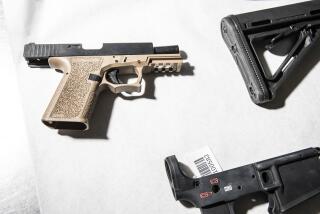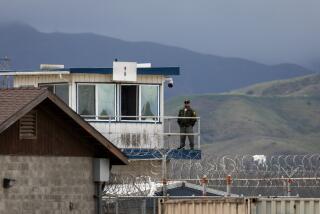Assault Gun Ban Gains in Legislature : Despite Pro-Weapon Lobbying, Panels in Both Houses OK Bills
- Share via
SACRAMENTO — The drive to rid California of military-style assault guns favored by street gangs, drug traffickers and other criminals scored a pair of important victories in the Legislature on Tuesday.
First, to a round of loud applause from members of Los Angeles neighborhood organizations, the Assembly Public Safety Committee approved, with no votes to spare, a bill to outlaw the manufacture, sale and possession of certain rapid-firing semiautomatic assault guns.
Four hours later, the Senate Judiciary Committee approved a broader measure, again by a thin margin.
Amended in Assembly
Pro-gun lobbyists argued that both bills were misdirected at guns rather than at criminals and that it could make lawbreakers of law-abiding gun enthusiasts who had legally purchased semiautomatic combat rifles.
The Assembly bill was substantially amended to narrow its scope in order to gain the necessary favorable votes.
Amid tightened security, upwards of 400 people, many of whom traveled overnight by bus from Los Angeles, packed the Capitol’s two biggest hearing rooms. Spectators were directed through an airport-style metal detector before being admitted to the Judiciary Committee hearing.
A Senate official who asked not to be identified said the extra security precautions were ordered because “some (Senate) members received threats, both written and by telephone.”
Although the Assembly author of the legislation, Mike Roos (D-Los Angeles), was forced to subtantially amend his bill to win approval of the Public Safety Committee, he hailed the vote as a major victory for public safety and a loss for the politically potent gun lobby.
“It’s still a very strong bill,” Roos declared. He forecast a “close vote” on the Assembly floor after the measure clears the Ways and Means Committee, its next stop.
Senate leader David A. Roberti (D-Los Angeles) carried a virtually identical bill, but managed to steer it through the Judiciary Committee without making major changes. The vote was 6 to 5.
“Every day, day in and day out, week in and week out, month in and month out, people are being killed in California (by assault guns),” Roberti argued. “It’s a shame that we have become so hardened to these killings that we are not even shocked any more.”
Both bills still face an uphill battle in a Legislature that traditionally has been reluctant to establish restrictions on guns. Conceivably, a final compromise program will be written by a Senate-Assembly conference committee sometime this summer.
The California hearings were being closely monitored throughout the country as a test of strength of gun lobbies and of organizations opposed to assault rifles.
Roos opened the Public Safety Committee hearing by playing an audio tape of semiautomatic gun fire. Was it Beirut, Vietnam or Rambo Part V? he asked rhetorically.
“No,” he said. “It was downtown Los Angeles last New Year’s Eve. We must put a stop to this lunacy.”
The two bills, drafted by a task force of law enforcement officers headed by Atty. Gen. John K. Van de Kamp, originally set out to ban a wide range of high-powered, rapid-firing military rifles, including the Uzi, AK-47 and AR-15.
However, the National Rifle Assn. and other gun owner groups insisted that no clear distinction could be drawn between those weapons and “legitimate” hunting and sport firearms. The NRA mounted a massive lobbying campaign among its 250,000 California members to defeat the bills.
Semiautomatic rifles and shotguns can be purchased over the counter in the state by anyone 18 or older who displays standard identification. The potential purchaser of a handgun, however, must wait at least 15 days before taking possession of the firearm while the state conducts a criminal background check.
The murder of five children on a Stockton schoolyard Jan. 17 and the wounding of 29 others and a teacher by a demented gunman, Patrick Purdy, who was armed with an AK-47, ignited a groundswell of public opposition to semiautomatic assault weapons.
“Military assault weapons were designed for mass murder and they are excellent at it,” testified Van de Kamp, a 1990 Democratic gubernatorial contender. “They kill kids and they kill cops. They do not belong in the hands of any civilian in the state.”
Holding a blackjack, billy club and a pair of nunchaku fighting sticks, Van de Kamp noted that a gang member would be arrested for possessing any such illegal weapons. But hefting an AK-47, he told the committee, “If that same gang member walks by carrying an AK-47, there is nothing we can do. He walks on by.”
Assemblyman Charles W. Quackenbush (R-Saratoga), the target for more than a week of intense lobbying by both sides who had opposed the Roos bill, provided the crucial fifth vote in the Public Safety Committee to approve the measure.
As the 5-3 vote was announced, the audience, including members of the South Central Organizing Committee, East Valley Organization and United Neighborhood Organization in Los Angeles, burst into enthusiastic applause.
The action followed acceptance by Roos of amendments proposed by Quackenbush that eliminated a broad definition of what constituted an assault rifle. Substituted in its place was a list of about 40 rifles, shotguns and pistols that would be specifically banned by manufacturer and model, including the AK-47 and Uzi.
Last year, Roos unsuccessfully carried legislation that specifically would have banned nine semiautomatic guns by brand name and model. Tuesday’s votes presumably indicated a new climate in the Legislature.
The Quackenbush amendments also eliminated a proposed commission that would have been empowered to approve for sale and use in California new semiautomatic guns as they were developed. Critics had charged that the Legislature should make such decisions and not delegate it to an “unaccountable” commission.
Van de Kamp argued against writing into law specific guns to be banned, warning that manufacturers could get around the prohibition merely by renaming the firearm or making simple cosmetic changes in the weapon’s design.
As approved by the Senate committee, Roberti’s bill retains the broad definition of an assault rifle and keeps intact the assault rifle commission that was stripped from the Assembly bill.
In a low-key presentation to both committees, the NRA and the California Rifle and Pistol Assn. offered only three witnesses. They argued, basically, that gun abusers are criminals and should be toughly dealt with as criminals but that it is “misguided” to ban assault guns.
Gun lobbyist Kent L. DeChambeau contended that when a crime occurs with a firearm, it does not matter whether the weapon is an assault type. “It’s an improper use of a firearm. We must get off this idea that we can cure the problem by legislating or banning the device (gun),” he said.
He drew support from Sen. John Doolittle (R-Rocklin), who termed the bill “sort of a Ban the Bomb approach applied to assault rifles. . . . There’s many Patrick Purdys out there, unfortunately. I don’t see this bill dealing with the overall problem in this society.”
More to Read
Get the L.A. Times Politics newsletter
Deeply reported insights into legislation, politics and policy from Sacramento, Washington and beyond. In your inbox twice per week.
You may occasionally receive promotional content from the Los Angeles Times.









